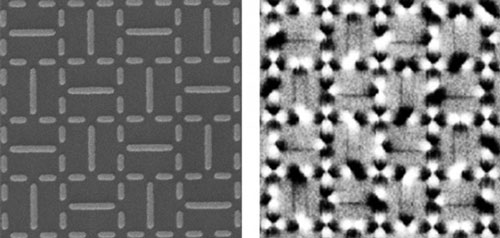| Posted: Apr 27, 2015 |
Artificial spin ice: A new playground to better understand magnetism
|
|
(Nanowerk News) For the first time, nanomagnet islands or arrays were arranged into an exotic structure (called “shakti”) that does not directly relate to any known natural material ("ARTIKEL"). The shakti artificial spin ice configuration was fabricated and reproduced experimentally. The arrays are theoretical predictions of multiple, or degenerate, ground states that are characteristic of complex frustrated magnetic materials.
|
 |
| Scanning electron micrograph (left) shows the arrangement of iron-nickel nanomagnets for the newly developed “shakti” artificial spin ice lattice. In the lattice, 2, 3, and 4 nanomagnets meet in periodic arrays. Magnetic force microscope image (right) shows the poles of the nanomagnets (dark and light contrast).
|
|
The Impact
|
|
Complex nanomagnet arrays with exotic geometries can be designed and fabricated to exhibit desired physical phenomena and subtle effects. The results open the door to experiments on other artificial spin-ice lattices, predicted to host interesting phenomena. The phenomena are associated with the design of the exotic lattice structures where the topology governs the physics and properties of the material.
|
|
Summary
|
|
Artificial spin ice is a class of lithographically created arrays of interacting ferromagnetic nanometer-scale islands. Researchers created artificial spin ice as a means to investigate complex magnetism and the related physics in a material that could be tailored to precise specifications and imaged directly. Because of the large magnetic energy scales of these nanoscale islands, a special, newly developed thermal treatment is required to achieve the magnetic ground state.
|
|
In this research, iron-nickel nanomagnets were fabricated in shakti arrays, a structure with 2, 3, and 4 nanomagnet islands meeting in periodic arrays (resulting in vertexes with 2, 3, and 4 coordination numbers). Then, the structure underwent a thermal treatment by heating it above the Curie temperature (the temperature at which the nanomagnets become magnetic). In this manner, the artificial spin ice achieved unprecedented thermal ground state ordering of the magnetic moments.
|
|
In these investigations, the shakti spin ice lattices were used to experimentally confirm the ground states of the lattice predicted by Monte Carlo simulations and to study the dynamics and charge screening effects for the system.
|
|
Publications
|
|
Nature Physics ("Emergent ice rule and magnetic charge screening from vertex frustration in artificial spin ice")
|
|
Nature ("Crystallites of magnetic charges in artificial spin ice")
|

